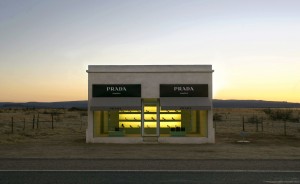
Associated Press
EL PASO — The Prada Marfa art installation has stood alone in the West Texas plains for eight years, its high-end Italian fashion goods available to no one.
Now, state officials say the shack-sized building along a rural U.S. highway near Marfa is an illegal roadside advertisement, and they’re considering what to do about a structure that’s a must-see for passing tourists and a must-hit for vandals.
Artists Michael Elmgreen and Ingar Dragset designed the piece to resemble a Prada storefront and slowly disintegrate. It went up in 2005 on private land in Valentine, Texas.
But it wasn’t in the sights of the Texas Department of Transportation until Playboy this summer installed a 40-foot neon bunny along the same highway.
TxDOT spokeswoman Veronica Beyer says both the Prada Marfa and the Playboy bunny are considered signs under Texas law, meaning it’s something intended to advertise, including logos. The bunny sculpture is the magazine’s iconic logo, while the fake store has the Prada logo on its awnings. Under federal law, a permit is needed to display signs along a U.S. highway.
“We know it’s illegal. They don’t have licenses, they don’t have permits,” Beyer said. And both displays sit on land that does not qualify for obtaining permits.
Boyd Elder, a local artist and Prada Marfa site representative, disagrees.
“It’s not advertisement, it’s not a store, no one is selling anything there. It’s an art installation,” he said.
The state ordered the bunny to be removed by late October, though it gave the company a 60-day extension to allow them to find a solution.
TxDOT hasn’t yet determined whether to take similar action against the Prada Marfa.
If the state and the artists do not find a way around the law that prohibits signs on public highways, TxDOT stands to lose federal funds at a time when budget constraints made it consider asking cities to take over the maintenance of some state roads.
“If Texas did not effectively control outdoor advertising it would be subject to losing 10 percent of its federal-aid highway funds,” Beyer said.
PR Consulting, a public relation firm representing Playboy, said the TxDOT issued the removal notice, but then immediately extended the deadline, “reflecting our mutual desire to keep the discourse open.”
Houston-based attorney Dick Deguerin was involved in discussions with TxDOT to try to find a solution for the Playboy bunny and the Prada storefront, Elder said. Deguerin didn’t immediately respond to a request for comment.
Elder said the idea was originally to place the installation along a highway that leads to Las Vegas.
“It was going to be called Prada Nevada, but then someone suggested we put it in Valentine, and we all laughed,” he recalls. “It was a joke to put it in the middle of nowhere.”
Since it opened, vandals have hit the store numerous times, including a break-in where thieves discovered the bags — which sell for hundreds of dollars — had the bottoms removed and only the right shoe of each pair was on display. The window panes were eventually replaced with bullet-resistant polycarbonate.
Elmgreen and Dragset didn’t immediately respond to an email request for comment.
The artists “want people’s reaction to their art,” Elder said. “ … Maybe this (TxDOT decision) is the ultimate reaction to the art itself.”



